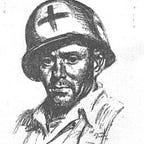NATO SOF Medical Research Workshop on Major Joint Operations
Written by Major Jeff Johnson
In late September 2019, at the Victory Service Club in London, military medical personnel from 17 nations gathered for the NATO Special Operations Headquarters (NSHQ) annual Medical Research Workshop to discuss the topic of Major Joint Operations (MJO), NATO’s name for Large Scale Combat Operations. The medical capabilities of Special Operations Forces (SOF) units are very limited, so this workshop focused on conventional forces’ medical support to MJO, and how to integrate SOF into that system. Over three days, experts spoke on various topics from historic medical perspectives of past MJOs, to the implications of a paradigm shift from Small Joint Operations like Afghanistan, back to MJOs like World War II with new twists.
History does not repeat itself, but it sure does rhyme.
One of the first speakers was a Dutch historian who examined MJOs from 1800 to 2000. He observed that commanders are more interested in fighting capabilities like tanks and aircraft than they are in medical support and they quickly become disinterested when medical becomes a hindrance to their intent and vision. Leaders who focus on the last war tend to also focus on the medical freedoms and constraints experienced in that last war. Throughout the battlefields of Europe and America, preventive medicine was often overlooked; military medicine focused on evacuation and medical support needed to be tailored to the unit it was assigned. His final point was how military medical systems drain civilian medical systems both in the areas where armies are fighting and the areas they come from. This drain negatively affects the civil-military operations on the frontline and the morale on the home front. MJOs of the future will look different from MJOs of the past, but there is still much that can be learned from history.
The more you sweat in peace, the less you bleed in war.
NSHQ’s J7 Exercise Director briefed NATO’s renewed focus on MJO during their exercises. The challenges and gaps these exercises expose are not always medical in nature but have significant medical implications. During a recent exercise in Norway, communications were frequently interrupted, the Joint Operations Area (JOA) became the focus while activity outside the JOA was ignored, and there were four separate Rules of Engagement (ROE) for different parts of the battlefield. A large number of casualties overwhelmed the transportation and healthcare infrastructure and compromised civil-military relations. The training unit established a Patient Evacuation Control Center, but they did it incorrectly and struggled with patient movement in northern Norway the entire exercise. The key problem with exercising medical is that it creates big problems, but some medical problems are slow to build up and difficult to incorporate into a ten-day exercise. Lessons from exercises like these can be painful, but they are the best way to improve medical support to operations and realign allied militaries to fight MJOs.
“Golden Hour to Golden Day,” GEN John M. Murray, Commanding General Army Futures Command.
A speaker from the Combat Casualty Care Research Program discussed why the concept of the “golden hour” will not be attainable in MJO. He posits that the goal will shift from “save every life” to “save the most lives.” The lack of air superiority, large volumes of casualties, and contested communications will create problems for treatment, evacuation, and regulation. This highly mobile and lethal battlefield will challenge logistics and attrit medical assets. The speaker shared innovations his team is working on such as advanced bio sensors and drones for medical evacuation and medical resupply to mitigate these future challenges. Implementing innovations and improving these advances and best practices will enable medical leaders to stay relevant in the evolving battlefield.
Knowing is half the battle.
Throughout the workshop, key tasks for medical planners during the phases of competition, crisis, and conflict emerged. Competition phase is the ideal time to build relationships with allied and partner medical personnel, participate in exercises, and integrate medical systems and requirements into the other staff sections of the unit. During crisis phase, ensure lines of communication, maintain creativity and flexibility, and facilitate civil-military operations. For conflict phase, understand missions and plans across the conflict spectrum, build a Medical Common Operating Picture (COP) and think through multi-domain, multi-terrain, and multi-climate requirements. The fourth SOF truth is that competent SOF cannot be created after emergencies occur, and the same is true for medical support.
MAJ Jeff Johnson currently serves as the Medical Operations Branch Head, NATO Special Operations Headquarters. Previously he has served in various command and staff positions, most recently serving with 1st Special Forces Group.
The views expressed in this article are the authors’ alone and do not reflect the official position of the Medical Service Corps, the Department of Defense, the Defense Health Agency, or the US Government.
